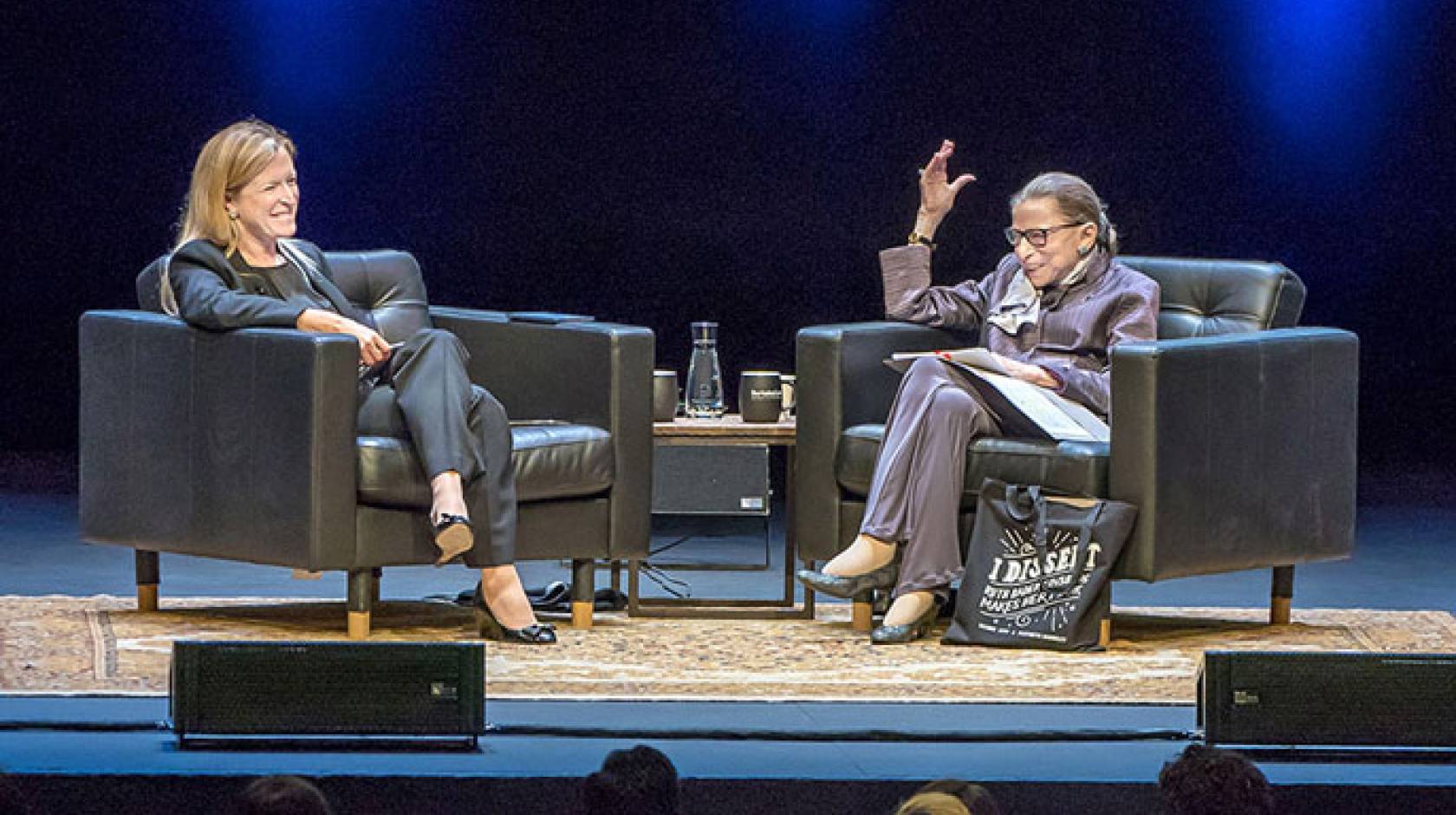Andrew Cohen, UC Berkeley

Small in stature but a towering icon, Supreme Court Justice Ruth Bader Ginsburg was the obvious choice to give Berkeley Law’s inaugural Herma Hill Kay Memorial Lecture.
Trailblazers for women in the law and gender equality and co-authors of the first-ever casebook on sex-based discrimination, they were good friends for decades before Kay — a beloved figure who taught for 57 years at Berkeley Law and was its first woman dean — died in 2017.
Monday afternoon, before a packed house of Berkeley Law students, faculty, and staff at Zellerbach Hall, Ginsburg described meeting Kay at a 1971 conference on women in the law. “The rest of that decade, Herma was my best and closest working colleague,” she said.
The justice received spirited standing ovations before and after the event. Dean Erwin Chemerinsky said, “I know it’s cliché to say while introducing someone that the person needs no introduction, but I cannot imagine an instance where it’s more true than this one. After all, this is the first justice in history who is widely publicly known by just initials.”
UC Berkeley Chancellor Carol Christ called Ginsburg “one of the nation’s most important legal minds” and “a role model for millions.” The university’s provost while Kay was Berkeley Law’s dean from 1992 to 2000, Christ praised her “brilliance, grace, humor, tact, and unyielding resolve that saw her shatter barriers in the legal world.”

Credit: Berkeley Law
Together, she said, Ginsburg and Kay (both of whom graduated from law school in 1959) were “part of a small band of outsiders who braved rejection, isolation, and hostility to establish an initial foothold in legal education. They helped pave the way for a proliferation of women lawyers, judges, and law professors … The ground they broke is now well trod and we hold them in our debt.”
Berkeley Law professor Pamela Samuelson donated the seed money to launch the lecture series with her husband, UC Berkeley School of Information professor Robert Glushko. During a slideshow featuring photos of Kay, Samuelson praised her for improving the law school’s faculty diversity, clinical program, and social justice programming. “I’m only one of many thousands of women in particular who were inspired by her and mentored by her,” she said.
While Kay became a top authority on family law, conflicts of law, and sex-based discrimination soon after joining Berkeley Law in 1960, Ginsburg also became a revered law professor before founding the ACLU Women’s Rights Project and litigating landmark cases. Kay was just the 15th woman tenured law professor in the U.S. and the second at Berkeley Law; Ginsburg was the 19th in the U.S. and the first at Columbia Law School.
The primary drafter of California’s Family Law Act of 1969, the nation’s first no-fault divorce law that became a template for similar laws nationwide, Kay “strived to make marriage and divorce safer for women,” Ginsburg said.
During Ginsburg’s 1993 Supreme Court confirmation hearings, Kay testified on her behalf and said, “I can tell you that her compassion is a deep as her mind is brilliant.” In 2015, Kay received the Association of American Law Schools’ Ruth Bader Ginsburg Lifetime Achievement Award from the justice herself.
Candor and conviction
Soon after giving prepared remarks about Kay, Ginsburg engaged in an hour-long interview with Berkeley Law professor Amanda Tyler, her former clerk.
In addition to Kay’s acumen and achievements, the justice recalled her “sense of style … she had her private pilot’s license and navigated the San Francisco hills in a sleek yellow Jaguar. Herma had a remarkable quality not easily captured in words. There was a certain chemistry in play, something that made you want to be on her side.”

Credit: Berkeley Law
Such personal remembrances punctuated Ginsburg’s comments about Kay — and about her own remarkable life. She spoke openly about her late husband Martin, their approach to marriage, how she navigated his cancer diagnosis as Harvard Law School students while raising their young daughter, and overcoming her own bouts with cancer.
Now 86, the Supreme Court’s oldest justice said she is doing “very well” compared to six months ago, and that her famous workout routine includes pushups and planks (“both front and side”).
While her interest in law bloomed early — at 13 Ginsburg wrote an article in her school paper touting the importance of the Magna Carta, Bill of Rights, and Declaration of Independence — she “didn’t think about the legal profession because women weren’t there.”
At Cornell, however, a professor discussed how attorneys were defending those being called in for questioning amid the wave of Communist accusations led by Senator Joe McCarthy. Reading about their advocacy, “I got the idea that being a lawyer was a pretty nifty thing,” Ginsburg said.
She and Martin decided to pursue the same career, and he wanted to attend Harvard. “But Harvard Business School didn’t admit women in the 1950s … so that left law school,” said Ginsburg, one of just nine women in her class of over 500.
Gender inequity was hardly her only challenge in law school, however. When Martin was diagnosed with cancer, she juggled caring for him, her own rigorous law studies, enlisting some of his classmates to take notes for him, and tending to their daughter. Back then, she explained, there was no chemotherapy and radiation was not targeted, so Martin had massive radiation every day for six weeks.
“We just took each day as it came,” she said. “After those few hard months, I decided that whatever came my way, I could handle it. If you’ve survived cancer, you have a zest for life you didn’t have before. You count each day as a blessing.”
An uphill climb
Despite graduating at the top of her law school class, Ginsburg struggled to find a job. Title VII had not been enacted, anti-discrimination measures were not yet part of employment law, and firms were reticent to hire women. In law school, she routinely saw sign-up sheets for job interviews that explicitly said “Men only.”
“Very few firms were willing to take a chance on a woman and no firm was ready to engage a mother,” said Ginsburg, who landed a judicial clerkship only through the diligent efforts of a professor-mentor.
When she joined Rutgers’ law faculty in 1963, the Equal Pay Act had just been passed — but was widely ignored. When notified of her paltry salary, Ginsburg asked how much a man with similar experience was paid.
“The dean’s answer was, ‘Ruth, he has a wife and two children to support, you have a husband with a well-paying job.’ Women there began an equal pay suit, and after some years the suit was settled and the lowest increase any woman got was $6,000. It took a while for employers, including academic employers, to appreciate that the Equal Pay Act was law.”
Ginsburg described how her first gender-based discrimination case was on behalf of pregnant public school teachers. At that time, she noted, “maternity leave” entailed no pay and no guaranteed right to return to work.
While “overjoyed” to learn from Tyler that Berkeley Law’s current 1L class is 60 percent women (see Entering Class Profile), Ginsburg said unconscious bias remains a trying obstacle for gender equality in the law.
When Tyler relayed that her female students often seek advice on how to balance a demanding law career with wanting a family, Ginsburg replied, “My No. 1 advice is to choose a partner in life who thinks that your work is as important as his. Marty was always my biggest booster and he also wanted to be an equal partner in parenting.”
Grateful for her long marriage before Martin died in 2010, Ginsburg revealed that the best advice she ever received came from his mother — on their wedding day.
“Just before the ceremony, she said, ‘Ruth, I’d like to tell you the secret of a happy marriage: It helps every now and then to be a little deaf. If there’s a thoughtless word spoken, just tune it out.’ That’s advice I not only followed in marriage for 56 years, but also to this day in dealing with my colleagues.”

